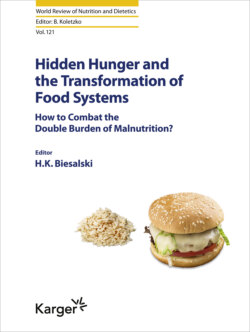Читать книгу Hidden Hunger and the Transformation of Food Systems - Группа авторов - Страница 49
Background
ОглавлениеConversely to the growth of supermarkets in the USA and Europe (historically in the first two-thirds of the 20th century), the expansion of supermarkets in SSA is happening at a much faster pace and only started in the late 1990s [8]. Except for a few large supermarket stores in big cities, where fresh fruits and vegetables are available, the expansion of supermarkets in SSA is especially characterized by the increasing offer of processed, dry, and packed foods [6, 9].
While the transformation of agri-food systems can create opportunities for domestic agriculture and food industries, challenges and possibilities for consumers concerning food consumption, nutrition, and health exist [7, 10]. The way retail outlets and their businesses are organized changes food environments and consumers’ food choices. Pricing, advertising, positioning, and the availability of different products and brands directly shape food preferences and create desires. Due to higher quantities traded and more efficient supply chains, supermarkets can sell certain foods at lower prices. Furthermore, supermarkets offer a wider range of types and brands of foods than traditional retailers and a different shopping atmosphere. While over-the-counter purchases are common in traditional retailers, supermarkets are self-service outlets. Hence, shopping in supermarkets is more autonomous, encouraging spontaneous purchase behavior and thus also changing people’s food choices and diets [11]. Besides personal preferences, habitual and every-day shopping practices, consumers’ choices are also affected by changing lifestyles and society.
The implications of the supermarket revolution for nutrition and health in LMICs are not yet well understood. For adults, some studies reveal significant associations between supermarket purchases and changing diets and nutrition. Studies from Tunisia and Vietnam found improvements in dietary quality through supermarket shopping [12, 13]. Studies from Indonesia, Guatemala, and Kenya suggest an association with higher energy consumption and a shift towards more processed foods through supermarket shopping [9, 14, 15]. Furthermore, some studies show significant links between supermarket shopping, higher body mass index (BMI), and higher risk of overweight and obesity [16, 17].
While evidence of the associations between supermarkets and adult nutrition in LMICs is relatively limited, studies that have looked at the implications for child and adolescent nutrition are even scarcer. One study from Indonesia found an increased risk of child overweight through supermarket shopping, but only for children in high-income households [18]. Results from Kenya do not show significant effects of supermarket shopping on child overweight rates, but suggest a positive effect on child height [17]. Furthermore, a cross-country analysis, including data from 41 LMICs, revealed a significantly negative association between the country-level share of supermarket retailing and child stunting, without finding any significant association between supermarkets and child overweight [19].
This discussion shows that the effects of supermarket shopping on diets, nutrition, and health are not straightforward and differ between adults, children, and adolescents. Causal inference is also tricky because most of the studies discussed used cross-section observational data where endogeneity bias is difficult to control. In the following, we review additional evidence from Kenya, where recent studies have used panel data for more robust causal inferences.
Table 1. Effects of supermarket shopping on adults’ diets and nutritional status
